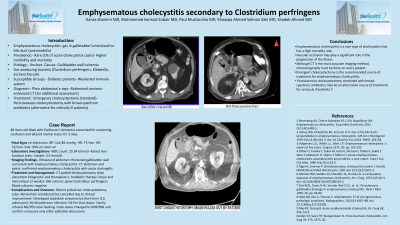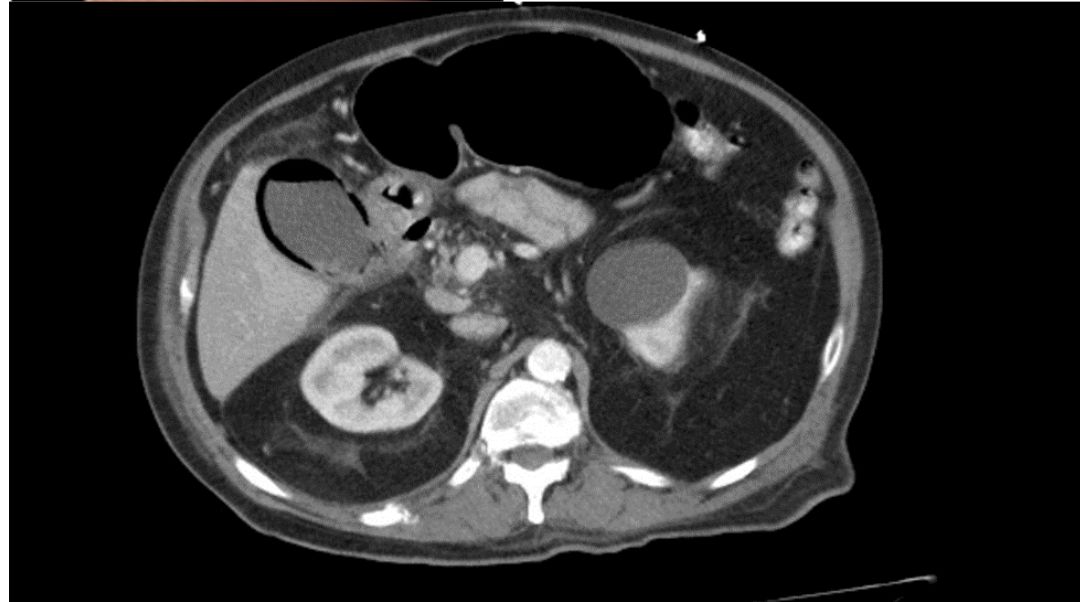Monday Poster Session
Category: Biliary/Pancreas
P1904 - Emphysematous Cholecystitis Secondary to Clostridium perfringens
Monday, October 28, 2024
10:30 AM - 4:00 PM ET
Location: Exhibit Hall E

Has Audio

Khawaja Ahmed Salman Zaki, MD
Nassau University Medical Center
East Meadow, NY
Presenting Author(s)
Kanza Shamim, MD1, Muhammad Sarmad Zubair, MD2, Paul Mustacchia, MD2, Khawaja Ahmed Salman Zaki, MD2, Shadab Ahmed, MD2
1Nassau University Medical Center, Merrick, NY; 2Nassau University Medical Center, East Meadow, NY
Introduction: Emphysematous cholecystitis (EC) is the presence of gas in the lumen and wall of the gallbladder and adjacent structures ¹,². EC is rare and is associated with notably higher morbidity and mortality. Although the etiology of EC is unclear, it has been suggested to be associated with gallbladder infection with gas-producing bacteria such as Clostridium perfringens, Klebsiella, and Escherichia coli ³. Patients With a history of diabetes and/or immunosuppression have been found to be susceptible to EC ⁴, ⁵. EC may be diagnosed via plain abdominal x-rays or abdominal contrast-enhanced computed tomography (CT) ⁴ .
Case Description/Methods: 88 Years old Male with dementia secondary to Parkinson’s disease (PD) presented with progressive lethargy, decreased appetite, and increased weakness over the past 3 days. Family denied any recent abdominal pain, nausea, vomiting and diarrhea. On examination Patient had poor baseline mental status. Abdomen was soft, non-tender and had no guarding or rigidity. The patient had significant leukocytosis and transaminitis. Abdominal ultrasound (U/S) showed no biliary ductal dilatation and thickened gallbladder wall consistent with EC. Patient underwent CT abdomen shows EC and ductal dilation concerning choledocholithiasis and cholangitis. Emergent cholecystectomy was declined by family. Patient underwent CT guided Cholecystostomy drain. Bile cultures grew Clostridium perfringens. The patient was started with IV Antibiotics (Zosyn and Vancomycin) with interval clinical improvement in the patient’s condition.
Discussion: EC is a rare type of cholecystitis with high mortality rate. Vascular occlusion may play a significant role in the progression of illness. It is not surprising that the diagnosis of EC implies a risk of gallbladder perforation that is five times higher than expected from typical acute cholecystitis because gangrene is a frequent feature of the pathologic process. ⁶ Although CT is the most accurate imaging method, ultrasonography must be done on every patient. Emergent cholecystectomy is the recommended course of treatment for EC. Percutaneous cholecystostomy combined with broad-spectrum antibiotics may be an alternative course of treatment for seriously ill patients ⁵ . Even though emergency cholecystectomy is the recommended course of treatment. However, to minimize anesthesia and surgery risk Percutaneous cholecystostomy combined with broad-spectrum antibiotics can also be an alternate approach for severely ill patients ⁷.

Disclosures:
Kanza Shamim, MD1, Muhammad Sarmad Zubair, MD2, Paul Mustacchia, MD2, Khawaja Ahmed Salman Zaki, MD2, Shadab Ahmed, MD2. P1904 - Emphysematous Cholecystitis Secondary to <i>Clostridium perfringens</i>, ACG 2024 Annual Scientific Meeting Abstracts. Philadelphia, PA: American College of Gastroenterology.
1Nassau University Medical Center, Merrick, NY; 2Nassau University Medical Center, East Meadow, NY
Introduction: Emphysematous cholecystitis (EC) is the presence of gas in the lumen and wall of the gallbladder and adjacent structures ¹,². EC is rare and is associated with notably higher morbidity and mortality. Although the etiology of EC is unclear, it has been suggested to be associated with gallbladder infection with gas-producing bacteria such as Clostridium perfringens, Klebsiella, and Escherichia coli ³. Patients With a history of diabetes and/or immunosuppression have been found to be susceptible to EC ⁴, ⁵. EC may be diagnosed via plain abdominal x-rays or abdominal contrast-enhanced computed tomography (CT) ⁴ .
Case Description/Methods: 88 Years old Male with dementia secondary to Parkinson’s disease (PD) presented with progressive lethargy, decreased appetite, and increased weakness over the past 3 days. Family denied any recent abdominal pain, nausea, vomiting and diarrhea. On examination Patient had poor baseline mental status. Abdomen was soft, non-tender and had no guarding or rigidity. The patient had significant leukocytosis and transaminitis. Abdominal ultrasound (U/S) showed no biliary ductal dilatation and thickened gallbladder wall consistent with EC. Patient underwent CT abdomen shows EC and ductal dilation concerning choledocholithiasis and cholangitis. Emergent cholecystectomy was declined by family. Patient underwent CT guided Cholecystostomy drain. Bile cultures grew Clostridium perfringens. The patient was started with IV Antibiotics (Zosyn and Vancomycin) with interval clinical improvement in the patient’s condition.
Discussion: EC is a rare type of cholecystitis with high mortality rate. Vascular occlusion may play a significant role in the progression of illness. It is not surprising that the diagnosis of EC implies a risk of gallbladder perforation that is five times higher than expected from typical acute cholecystitis because gangrene is a frequent feature of the pathologic process. ⁶ Although CT is the most accurate imaging method, ultrasonography must be done on every patient. Emergent cholecystectomy is the recommended course of treatment for EC. Percutaneous cholecystostomy combined with broad-spectrum antibiotics may be an alternative course of treatment for seriously ill patients ⁵ . Even though emergency cholecystectomy is the recommended course of treatment. However, to minimize anesthesia and surgery risk Percutaneous cholecystostomy combined with broad-spectrum antibiotics can also be an alternate approach for severely ill patients ⁷.

Figure: CT scan shows Gas in Biliary tree and gall bladder
Disclosures:
Kanza Shamim indicated no relevant financial relationships.
Muhammad Sarmad Zubair indicated no relevant financial relationships.
Paul Mustacchia indicated no relevant financial relationships.
Khawaja Ahmed Salman Zaki indicated no relevant financial relationships.
Shadab Ahmed indicated no relevant financial relationships.
Kanza Shamim, MD1, Muhammad Sarmad Zubair, MD2, Paul Mustacchia, MD2, Khawaja Ahmed Salman Zaki, MD2, Shadab Ahmed, MD2. P1904 - Emphysematous Cholecystitis Secondary to <i>Clostridium perfringens</i>, ACG 2024 Annual Scientific Meeting Abstracts. Philadelphia, PA: American College of Gastroenterology.
